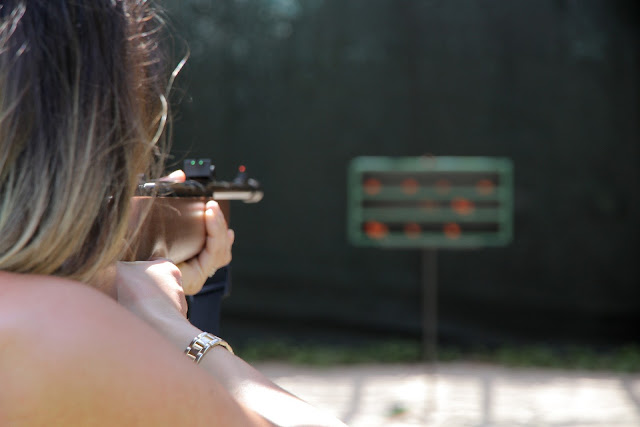Optical power, parallax, MOA.. What the heck does all that mean?
How to Pick the Right Rifle Scope
In recent years, the number of iron sights for sale at gun stores has gone down significantly, and if this isn’t a testament to the effectiveness of an optical scope, then we don’t know what is. Along with being ‘tacti-cool’, they make the entire shooting experience a bit more fun, and a lot more effective. The bottom line, is that scopes are an outstanding addition to virtually any rifle, whether you’re sitting at the end of the range, or crouching in the bush, waiting for the kill. Scopes allow us to see the target clearly, they allow a more precise aim, and quite frankly, it’s no surprise that so many people are choosing the scope over standard sights. If you’re new at this, then you’re probably going to run into a very serious problem: you won’t know what scope to choose. Don’t worry, you’re not the first person to experience that, and you won’t be the last. There are so many, all with different features, jargon, and capabilities. We’re going to give you a quick walkthrough that should help you to figure out what type of scope you need, and most importantly, what type of scope you don’t need.
Learning to Read your Scopes
• Magnification
• Objective Lens Diameter
The two items mentioned above are separated by an ‘x’, so, for example: 3-9x32mm. Sometimes, you will see the two numbers with a magnification dash between them, which tells you that the level of magnification can be adjusted from the lower number to the higher one, so, for example, if the number is 3-9, the magnification begins at three and can be increased to 9x. The second value is the diameter of the lens, which obviously cannot be changed. On the subject of the lens, the forward lens will hereafter be referred to as the objective lens.
Size vs. Functionality
As if you didn’t have enough to worry about, you also have to consider the reticle type. There are dozens of different patterns out there, from a simple dot, to a complex grid. That said, we’re only going to talk about two of them.
• Mildot – This reticle is similar to another, called the duplex (a simple crosshair) but it has several enhancements. For example, there is the size and spacing of the dots along reticle lines which correspond to specific angles. The mildot is currently used by military and law enforcement snipers, and with good reason. Most often, this scope type is great for distances beyond 300 yards, making it one of the best choices for long distance shooters.
• BDC – It stands for Bullet Drop Compensator, in case you were wondering. BDC’s are becoming more popular today, and they’re great for shooting targets at differing ranted without needing to change the elevation setting. The only problem is that they are only accurate at ranges beyond 500 yards, so if you were hoping to shoot a closer target, you’re out of luck.
MOA vs MRAD
• MOA – Stands for Minute of Angle and technically indicates 1/60th of an angular degree. More often than not, this is associated with linear inches, with 1 MOA corresponding to 1 inch at a distance of 100 yards. This allows for very precise zooming, as the adjustment increments are small. For long range shooters, the MOA scope is ideal.
• MRAD – Stands for Milradian, and is often abbreviated as MIL. Just like the MOA, the MRAD represents as a fractional section of an angle, and 1 milradian is 3.6 inches at 100 yards. Compared to the MOA, that’s a bit large, and that means you probably aren’t going to get the same precise adjustments. The good part, however, is that you can make simple adjustments, even though the adjustment knobs tend to be a liability in the field.
The Scope’s Focal Plane
Parallax in Rifle Scopes
In the case of most low magnification scopes, you will be parallax free at certain distances, say 100 yards as an example, and it will simply not be able to correct at close ranges. This is not a problem, as most scopes, at that range, would not really be able to register the shift, or it would be far too small to matter.
If you want to eliminate parallax without using an adjustment knob, you can pull your head back until the scope shadow is equal on all sides – this keeps your eyes at the same spot, and will also save you some time.
How Much Should You Be Spending on a Scope?
As with any product, there are those that really break the mold, and then you have those that are a step below excellent. Once again, it’s all about what you can afford, and secondly, what you need. Let’s take a quick look at some of the most popular brands, or rather, those at the top. They include:
• Nightforce
• Schmidt and Bender
• Leupold
While these brands are definitely desirable, they can cost up to $3,000, depending on the features present. What are you actually paying for? What features can you expect, and will they really make a difference? Some of the additional features can include:
• Increased Adjustment Precision
• Repeatability
• Optical Clarity
• Increased Durability
The most important thing for you to remember when you are in the market for a rifle scope is that yes, you can pay thousands of dollars for a good scope if you want to, but you absolutely do not have to. Think about this: commerce is better than ever, and you have more options than ever before. That said, the market for scopes is huge, so you can find the features that you want on your scope at a lower price, and you can probably find one at the same quality. The market is competitive, use that to your advantage.
Don’t go too cheap when you’re looking for a scope! This industry is just like any other: you get exactly what you pay for, and you don’t want to pay for a cheap rifle scope. The last thing you want is to find that it completely fails you while you’re in the field. Honestly, you should budget at least $200 for a basic scope, though if you can hit $300 you should be able to find something of decent quality. By dedicating $300 to your purchase, you will be able to jump on the advanced features like parallax adjustment, reticle illumination, and much more.
 |
| OffHand Gear Fleur D Lis hand guard shown |
Say What You Mean
You need to be very specific when you’re looking for a scope; there is really no room to fool around here. Fortunately, you have the internet, and most importantly, you have this article. There are so many different types of scopes available, and quite a few ways for you to find exactly what you need. Assuming you don’t want to do your shopping online, make sure that you know the terminology as you walk into a gun shop so that you can make the right decision when the time comes for you to lay your money on the counter.
Finally, if you are having any doubts, make sure you’re willing to shell out a bit more for a good brand name. The last thing you want to do is waste money on a cheaper scope, as they simply won’t perform in the field when timing matters. So, now you know how to plan your purchase, and how to find the scope that you need. Move forward, speak to experts, and mount the scope that will make your experience outstanding.
Rifle with OffHand Gear hand guard by: Michelle Sneed photography
Stock images from Pixabay








Here is excellent optical power rifle scope. All of the scopes that you have mentioned will satisfy our budget, however may also come up with crystal clean sight and precision so that you can get your target each single time. So, prevent losing valuable time and high priced ammunition and get a satisfactory scope that you may rely on.
ReplyDeleteYou have Shared great content here about. Ar15 Billet LowerI am glad to discover this post as I found lots of valuable data in your article. Thanks for sharing an article like this.
ReplyDeleteYou have provided valuable data for us. It is great and informative for everyone.Read more info about Complete Lower Parts Kitc Keep posting always. I am very thankful to you.
ReplyDelete카지노사이트핫Good to become visiting your weblog again, it has been months for me. Nicely this article that i've been waited for so long. I will need this post to total my assignment in the college, and it has exact same topic together with your write-up. Thanks, good share . Thank you because you have been willing to share information with us. we will always appreciate all you have done here because I know you are very concerned with our. Come here and read it once
ReplyDeleteChoosing the right rifle scope can be daunting, but understanding terms like optical power, parallax, and MOA is crucial. This insightful guide breaks down key components for informed decision-making.
ReplyDeleteNew Jersey Expunge Order of Protection
Great reading youur post
ReplyDeleteWith a return calculator, I know exactly how my SIP is performing.
ReplyDeletePlayers aiming to explore Switch games freely can rely on Switch Free Games as a useful resource. The website’s structured layout and accessible content make browsing both comfortable and informative.
ReplyDelete